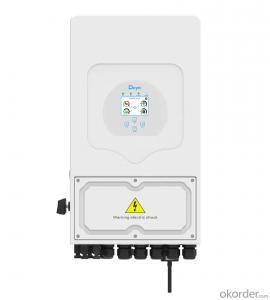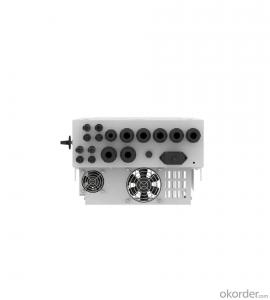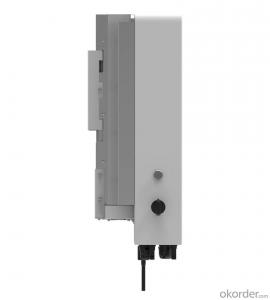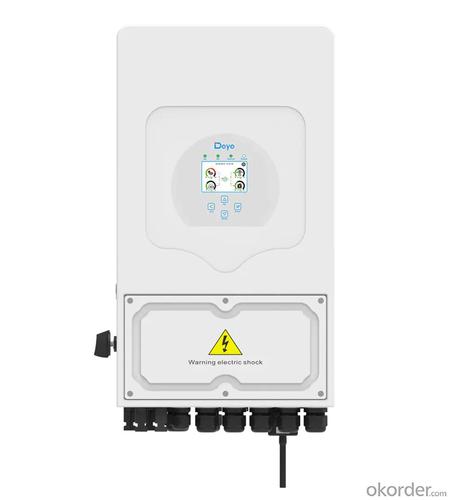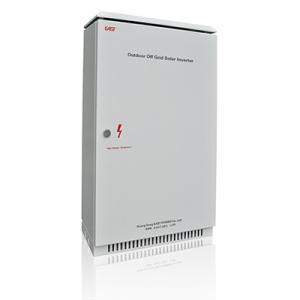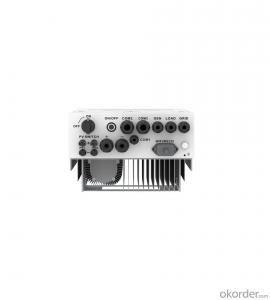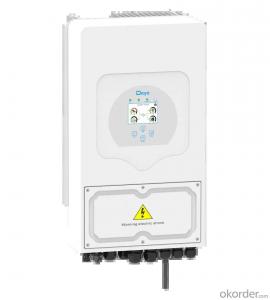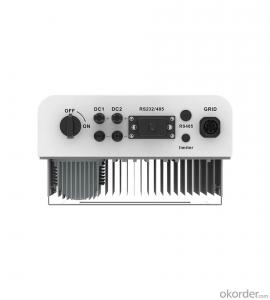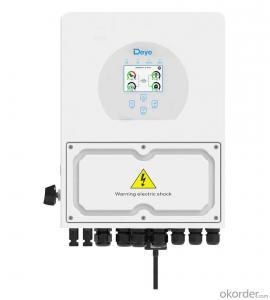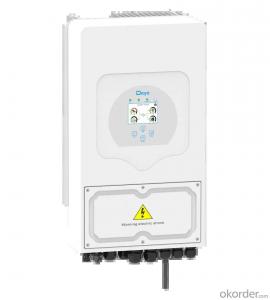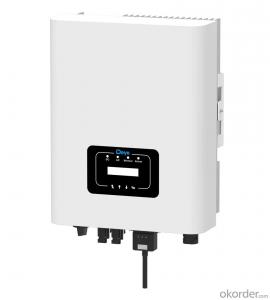Solar Inverter for Home - sun-3.6/5/6/7.6/8k-sg05lp1-eu 3.6-8kW Single Phase | 2 MPPT | Hybrid Inverter | Low Voltage Battery
- Loading Port:
- Ningbo
- Payment Terms:
- TT OR LC
- Min Order Qty:
- 100 pc
- Supply Capability:
- 5000 pc/month
OKorder Service Pledge
OKorder Financial Service
You Might Also Like
Specification
| Technical Data | |||||||
| Model | SUN-3.6K -SG05LP1-EU | SUN-5K -SG05LP1-EU | SUN-6K -SG05LP1-EU | SUN-7.6K -SG05LP1-EU | SUN-8K -SG05LP1-EU | ||
| Battery Input Data | |||||||
| Battery Type | Lead-acid or Li-lon | ||||||
| Battery Voltage Range (V) | 40~60 | ||||||
| Max. Charging Current (A) | 90 | 120 | 135 | 190 | 190 | ||
| Max. Discharging Current (A) | 90 | 120 | 135 | 190 | 190 | ||
| External Temperature Sensor | Yes | ||||||
| Charging Curve | 3 Stages / Equalization | ||||||
| Charging Strategy for Li-Ion Battery | Self-adaption to BMS | ||||||
| PV String Input Data | |||||||
| Max. DC Input Power (W) | 4680 | 6500 | 7800 | 9880 | 10400 | ||
| Rated PV Input Voltage (V) | 370 (125~500) | ||||||
| Start-up Voltage (V) | 125 | ||||||
| MPPT Voltage Range (V) | 150-425 | ||||||
| Full Load DC Voltage Range (V) | 300-425 | 200-425 | |||||
| PV Input Current (A) | 13+13 | 26+26 | |||||
| Max. PV ISC (A) | 17+17 | 34+34 | |||||
| No.of MPP Trackers | 2 | ||||||
| No.of Strings per MPP Tracker | 1 | 2 | |||||
| AC Output Data | |||||||
| Rated AC Output and UPS Power (W) | 3600 | 5000 | 6000 | 7600 | 8000 | ||
| Max. AC Output Power (W) | 3690 | 5500 | 6600 | 8360 | 8800 | ||
| AC Output Rated Current (A) | 16.4/15.7 | 22.7/21.7 | 27.3/26.1 | 34.5/33 | 36.4/34.8 | ||
| Max. AC Current (A) | 18/17.2 | 25/23.9 | 30/28.7 | 38/36.3 | 40/38.3 | ||
| Max. Continuous AC Passthrough (A) | 35 | 40 | 50 | ||||
| Peak Power (off grid) | 2 time of rated power, 10 S | ||||||
| Power Factor | 0.8 leading to 0.8 lagging | ||||||
| Output Frequency and Voltage | 50/60Hz; L/N/PE 220/230Vac (single phase) | ||||||
| Grid Type | Single Phase | ||||||
| DC injection current (mA) | THD<3% (Linear load<1.5%) | ||||||
| Efficiency | |||||||
| Max. Efficiency | 0.976 | ||||||
| Euro Efficiency | 0.965 | ||||||
| MPPT Efficiency | 0.999 | ||||||
| Protection | |||||||
| Integrated | PV Input Lightning Protection, Anti-islanding Protection, PV String Input Reverse Polarity Protection, Insulation Resistor Detection, Residual Current Monitoring Unit, Output Over Current Protection, Output Shorted Protection, Surge protection | ||||||
| Output Over Voltage Protection | DC Type II/AC Type III | ||||||
| Certifications and Standards | |||||||
| Grid Regulation | CEI 0-21, VDE-AR-N 4105, NRS 097, IEC 62116, IEC 61727, G99, G98, VDE 0126-1-1, RD 1699, C10-11 | ||||||
| Safety EMC / Standard | IEC/EN 61000-6-1/2/3/4, IEC/EN 62109-1, IEC/EN 62109-2 | ||||||
| General Data | |||||||
| Operating Temperature Range (℃) | -40~60℃, >45℃ derating | ||||||
| Cooling | Natural cooling | ||||||
| Noise (dB) | <30 dB | ||||||
| Communication with BMS | RS485; CAN | ||||||
| Size (mm) | 330W x 580H x232D | ||||||
| Protection Degree | IP65 | ||||||
| Installation Style | Wall-mounted | ||||||
| Warranty | 5 years | ||||||
| Weight (kg) | 24 | ||||||
Colorful touch LCD, IP65 protection degree
6 time periods for battery charging/discharging
Max. charging/discharging current of 120A
Max.16pcs parallel
DC couple and AC couple to retrofit existing solar system
Support storing energy from diesel generator
48V low voltage battery, safe and reliable
Unique Smart Load application and Grid peak shaving function 4ms fast transfer from on-grid to off-grid mode, ensuing the traditional fixed frequency air conditioner works well
SUN 3.6/8K-SG05,hybrid inverter, is suitable for residential and light commercial use, maximizing self-consumption rate of solar energy and increasing your energy impendence. During the day, the PV system generates electricity which will be provided to the loads initially. Then, the excess energy will charge the battery via SUN 3.6/8K-SG05. Finally, the stored energy can be released when the loads require it. The battery can also be charged by the diesel generator to ensure uninterrupted supply in the event of grid blackout.
It equipped with RS485/CAN port for battery communication
- Q: How does a solar inverter handle grid synchronization during startup?
- During startup, a solar inverter handles grid synchronization by employing a process called anti-islanding. The inverter continuously monitors the grid voltage and frequency to ensure that it matches the required standards. It remains disconnected from the grid until it detects stable and synchronized grid conditions. Once the grid parameters are within the acceptable range, the inverter synchronizes its output waveform with the grid and gradually ramps up its power production. This ensures a smooth and safe integration of the solar system with the grid, preventing any potential issues like islanding or instability.
- Q: Why is a solar inverter necessary in a solar power system?
- A solar inverter is necessary in a solar power system because it converts the direct current (DC) produced by solar panels into alternating current (AC) that can be used to power household appliances and be fed back into the grid. Without a solar inverter, the DC power generated by solar panels would be incompatible with the electrical grid and unable to be utilized effectively.
- Q: How does a solar inverter handle grid voltage variations?
- A solar inverter is equipped with a voltage regulation mechanism that allows it to handle grid voltage variations. It continuously monitors the grid voltage and adjusts the output voltage of the inverter accordingly to ensure a stable and consistent supply of electricity. This regulation mechanism helps to protect the inverter and the connected solar panels from any potential damage that may occur due to fluctuations in the grid voltage.
- Q: What is the role of a solar inverter in a solar power system?
- The role of a solar inverter in a solar power system is to convert the direct current (DC) electricity produced by the solar panels into alternating current (AC) electricity that can be used to power household appliances and be fed back into the electrical grid. The inverter also ensures that the power generated by the solar panels is at the correct voltage and frequency for safe and efficient use.
- Q: Grid-connected inverter is generally divided into photovoltaic power generation grid-connected inverter, wind power grid-connected inverter, power equipment and grid-connected inverter and other power generation equipment power generation inverter.
- Grid-connected inverter is generally used with large-scale photovoltaic power plant system, a lot of parallel PV string is connected to the same set of inverter DC input, the general power of the use of three-phase IGBT power module, power
- Q: What are the key safety features to look for in a solar inverter?
- The key safety features to look for in a solar inverter include: 1. Overvoltage and undervoltage protection: This feature ensures that the inverter can handle voltage fluctuations and prevents damage to the electrical system. 2. Ground fault protection: It is essential for the inverter to have ground fault protection to prevent electric shocks and ensure the safety of the system. 3. Anti-islanding protection: This feature ensures that the solar inverter shuts down in the event of a power outage, preventing it from sending power back to the grid and endangering utility workers. 4. Overtemperature protection: A reliable solar inverter should have overtemperature protection to prevent overheating and potential fire hazards. 5. Surge protection: The inverter should have built-in surge protection to safeguard against power surges caused by lightning strikes or grid fluctuations. 6. Arc fault protection: This safety feature detects and mitigates the risk of arc faults, which can result in electrical fires, by rapidly shutting down the inverter. 7. Monitoring and fault detection: A good solar inverter should have a monitoring system that detects faults or abnormalities in real-time, allowing for prompt maintenance and troubleshooting. 8. Compliance with safety standards: Ensure that the solar inverter complies with relevant safety standards, such as UL (Underwriters Laboratories) or IEC (International Electrotechnical Commission), to guarantee its safety and reliability. By considering these key safety features, you can ensure the overall safety and performance of your solar inverter system.
- Q: What is the maximum number of solar panels that a solar inverter can support?
- The maximum number of solar panels that a solar inverter can support depends on the specific model and its capacity. However, most solar inverters are designed to support a certain capacity or power rating, rather than a specific number of panels. The capacity of the solar inverter, measured in kilowatts (kW) or megawatts (MW), determines the maximum power output it can handle. The number of panels that can be connected to the inverter depends on the power rating of each panel. So, it is best to consult the manufacturer's specifications or seek professional advice to determine the maximum number of panels that can be supported by a specific solar inverter.
- Q: How do you size a solar inverter for a solar power system?
- To size a solar inverter for a solar power system, you need to consider the maximum power output of your solar panels. This can be determined by looking at the wattage rating of each panel and multiplying it by the number of panels in your system. Once you have the total power output, you should choose an inverter with a capacity slightly higher than the calculated value to allow for any future expansions or increases in power generation. Additionally, it is important to consider the type of inverter, such as string, micro, or hybrid, based on the specific requirements and constraints of your solar power system.
- Q: Can a solar inverter be used with different types of energy storage systems?
- Yes, a solar inverter can be used with different types of energy storage systems. Solar inverters are typically designed to convert the direct current (DC) generated by solar panels into alternating current (AC) that can be used to power household appliances and other electrical devices. They can be integrated with various energy storage technologies such as batteries, supercapacitors, and flywheels to store excess energy generated by the solar panels for later use. The compatibility between the solar inverter and the energy storage system may depend on factors such as voltage requirements, capacity, and communication protocols.
- Q: Can a solar inverter be used with a solar-powered electric vehicle charging station?
- Yes, a solar inverter can be used with a solar-powered electric vehicle charging station. The solar inverter helps convert the direct current (DC) power produced by the solar panels into alternating current (AC) power that can be used to charge electric vehicles. This allows for efficient and sustainable charging of electric vehicles using solar energy.
Send your message to us
Solar Inverter for Home - sun-3.6/5/6/7.6/8k-sg05lp1-eu 3.6-8kW Single Phase | 2 MPPT | Hybrid Inverter | Low Voltage Battery
- Loading Port:
- Ningbo
- Payment Terms:
- TT OR LC
- Min Order Qty:
- 100 pc
- Supply Capability:
- 5000 pc/month
OKorder Service Pledge
OKorder Financial Service
Similar products
Hot products
Hot Searches
Related keywords
